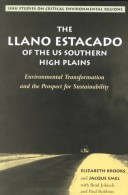The Llano Estacado straddles the Texas-New Mexico border, nestled between the Texas Panhandle and the Pecos River Valley. It was described by early Spanish explorers as an arid, featureless landscape, and, according to Mexican and Anglo-Texan lore, was the last refuge of the uncivilized. The region attracted Comancheros, marauding outlaws and renegades who plagued civil society. This book traces the history of the Llano Estacado - especially its radical transformations following the Civil War as railroads opened the beef trade, the discovery of rich oil deposits in the 1920s, and the decision made in the 1930s to tap the Southern Ogallala Aquifer to irrigate the region's farms. The authors focus in part on the consequences of modern irrigation, and concerns that the Ogallala Aquifer-a storehouse of fossil water dating back to the post-Cretaceous period-will be depleted. They conclude that the Llano Estacado is a ""partially threatened"" region, and explore its future sustainability.
- ISBN10 9280810421
- ISBN13 9789280810424
- Publish Date 30 January 1999
- Publish Status Out of Stock
- Publish Country JP
- Imprint United Nations University
- Format Paperback (US Trade)
- Pages 176
- Language English
